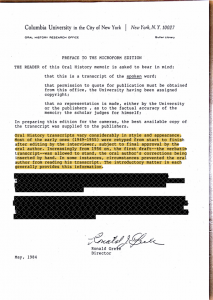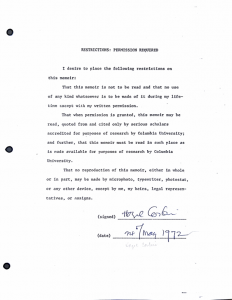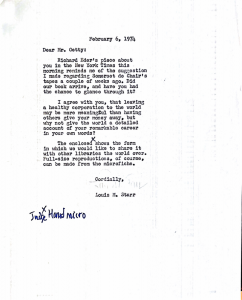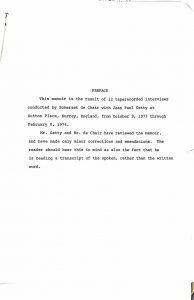 Oral history transcription practice has undergone several changes since implemented at the inception of the field’s standardization and formalization starting in the late 1960s. The oral history transcripts selected for the “Lost in Transcription” case in the Rare Book & Manuscript Library’s exhibition, Original Copies: Facsimiles & Mediations of Authenticity & Ownership, reflect different iterations of transcripts in the Oral History Archives at Columbia (OHAC). These changes illustrate contradictions and ambivalence related to ethics, accessibility, time, labor, and use.
Oral history transcription practice has undergone several changes since implemented at the inception of the field’s standardization and formalization starting in the late 1960s. The oral history transcripts selected for the “Lost in Transcription” case in the Rare Book & Manuscript Library’s exhibition, Original Copies: Facsimiles & Mediations of Authenticity & Ownership, reflect different iterations of transcripts in the Oral History Archives at Columbia (OHAC). These changes illustrate contradictions and ambivalence related to ethics, accessibility, time, labor, and use.
There’s much to say about the evolution of transcription-as-practice in oral history methodology. Let’s start with the assumption of “evolution” as marking a progress narrative or one of improvement. As with any research methodology, practitioners and theorists should be responsive to ethical changes in the field, as well as shifts in structural conditions that require rethinking methodologies. Consistent considerations include labor practices and costs. To do otherwise risks miring oral historians and archivists in potentially ineffective and sometimes expensive workflows. Too, with oral historians documenting lives as a priority, and not processes, rationales for certain practices can be lost to time. If historic processes no longer serve the purpose of access, use, and preservation archivists and curators are obliged to update and document workflows to keep pace with contemporary needs and goals.
Transcription, ethics, and resources
At its inception in the 1948, the Oral History Research Office (or OHRO, as it was known then) was an independently funded entity outside of the University’s library system. As detailed in the exhibition, Meddlesome Practices: Oral Histories of Good Troublemaking in Business, OHRO founder Allan Nevins wanted to ensure that business history was considered “serious history” and a significant sub-field in historical studies. He followed a “Great Men,” top-down model of history by inviting esteemed men in business and philanthropy, with deep pockets, to sit for an oral history interview. Some interviews were many-hour, thousand page transcript affairs. Nevins and his team told narrators that they would have the opportunity to review the transcribed interview in a process they named “audit-editing.” Borrowing from accounting, oral history narrators were encouraged to perform a kind of “self accounting” by reviewing the transcribed interview for inaccuracies in the transcription, change incorrect or misremembered assertions, and perhaps fill in gaps where memory might have failed them during the oral retelling of their life histories.
As one can imagine, though thousands of narrators returned their transcripts with corrections that were then re-typed as a “clean” copy, bound as a hardback book, and installed in the University’s library as a published work, at some point, the workload for a self-funded operation resulted in a reconsideration of the labor and costs associated with re-typing and binding interviews. Additionally, sometimes narrators never returned their audit-edited transcript leaving hundred of interviews in a state of limbo. Did silence mean the narrator approved the transcript as-is? Typically, OHRO project records show that when narrators were displeased with their transcripts, they returned them with annotations or even requested the interviews not be made available because how they sounded “on paper” was not as eloquent as they would have liked.
Buddy, can you spare…a grand?
Oral histories with union organizer and strategist Louis Goldblatt, and with health expert and pioneer in infant and maternal care Hazel Corbin, are representative of transcripts that were transcribed from the audio version, presumably audit-edited by the narrators (though project files often reflect the labor of women working as executive assistants and secretaries completing this task and communicating with the OHRO staff), retyped by OHRO staff, and then bound as hardback books to be presented on the library shelves. This audit-editing and publishing process validated for narrators the importance of their life histories as History-writ-large, as well as offered credibility to the entire enterprise’s goal of being taken seriously as a methodology. Publication was also a key fundraising tool for the early self-funded OHRO to secure more funds for operations with Nevins and later OHRO director Louis Starr notifying narrators of publication and soliciting a donation to continue the work.
What do you mean there’s no recording?
Also notable about transcription are implications for the use, re-use, preservation, or disposal of analog media used for recording. Interviews were typically recorded on reel-to-reel magnetic tape and later tape cassettes. Because the interviews were transcribed, the published book was considered the final artifact, and recordings were thought to be no longer needed, OHRO sometimes reused materials by recording over them as a cost-savings measure. We lack policy or workflow documentation to tell us why some interviews’ reels and cassettes were kept in the archive, or why some interviews no longer have associated audio.
There did come a time when the pressures of self-funding and amassing interviews introduced a change in whether transcripts were audit-edited or retyped at all. With U.S. industrialist Jean Paul Getty’s bound oral history transcript as an example, we can see handwritten edits in the version that sits on the library’s shelves and is available for research review.
Though the return of an audit-edited transcript to the OHRO remained an issue that no amount of cajoling or frequency of correspondence could remedy, we find in the archive transcripts that were audit-edited and deemed suitable for use without retyping them. This may have been down to a lack of staff or students to perform the time-consuming labor of transcription and/or a lack of funds to pay for transcription with a commercial service.
Regardless, for interviews with handwritten corrections, strike-throughs, annotations, etc., was it the narrator’s intent for researchers to witness these markings? Was it ethically sound for the OHRO to promise to retype transcripts, but often several years or decades later present those handwritten annotations to the public? This dilemma is both an historical one and an ethical one. If oral history transcripts are historical documents, narrators’ annotations offer researchers insights into what was said, but also what narrators thought better of, misremembered or corrected. Visual annotations create a layered textual narrative. Without documentation outlining policy, it appears that the commitment to retype a transcript after audit-editing was dispensed with in favor of making materials available to researchers in the archives. In previous iterations of the Oral History Research Office, staff acted as rigorous gatekeepers of access to materials, in line with prevailing practices of the day for submitting one’s credentials and reasons for accessing archival materials. This type of screening, as well as the past requirement that researchers secure permission from the archive to cite or quote, may have been one way to navigate annotations in transcripts (1). The stipulation of “permission required to cite and quote” was dispensed within 2017.
Hand-corrected transcripts also raise a related issue of one-to-one correlation between the transcript and interview audio. For an oral history interview where only a transcript is listed in its catalog record, this tends to indicate that there is no surviving audio. However, it may be the case that, if there is audio available, the transcript may have been edited while the audio was not. It’s unlikely that OHRO personnel, given the volume of interviews, lack of funding, and small staffing resources, spent time splicing and editing tape with a razor blade to make sure that audit-edited transcripts and audio matched. For this reason, with the fruits of a recent large-scale audio reformatting project, researchers may very well find discrepancies between transcripts and newly available audio.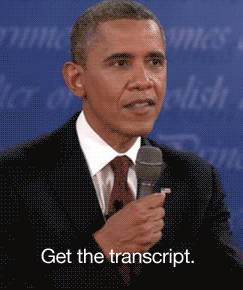
This mismatch would be the case with journalist Fern Marja Eckman’s interview with noted author James Baldwin, which appears in this exhibit as an edited transcript and in book form. The Baldwin interview is a unique instance in that we’re able to listen to the unedited audio (totaling over seven hours) and compare it with the edited transcript and final book – presumably edited by Eckman to align with her vision of Baldwin. Even with contemporary commitments to respecting narrators’ wishes and annotations by only presenting corrected transcripts, and the availability of audio editing software, narrators are warned that audio will not be edited, in which case they may choose to have only the written transcript available to researchers.
Additional dilemmas of transcription
To transcribe or not to transcribe?
Popular astrophysicist and science communicator Neil DeGrasse Tyson explains why he preferred that only the audio for this oral history interview for the September 11, 2001 Narrative and Memory Project be made available to researchers. Though transcribed in the interest of preservation, the 124 page transcript is closed to users. Here Neil DeGrasse Tyson explains his philosophical objection to transcribing an oral history interview.
Audio Player
Tyson conflates oral traditions and oral history, but his objection resurfaces questions about methodological purity and whether, in their very formulation, oral histories are meant to be received through aurality and not the written form. Yet, a refusal of transcription exclude researchers with hearing impairments, as well as researchers who can’t make their way to the oral history archives’ reading rooms to listen to audio or read transcripts that have not been published online (2).
Transcription and multilingual collections
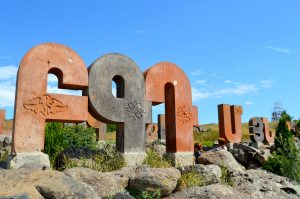
The Columbia Armenian Oral History Archive, a collection of audio and video recordings of Armenian first-person accounts recorded after they had immigrated to the United States. The collection consists of 138 interviews in Armenian, English, and Turkish languages. These interviews have not been transcribed due to the number of languages and, within those languages, dialects. Would transcription make this collection more accessible or less so? Does the absence of transcription force the user to listen to the materials in their original form and engage with the methodology’s inherent orality? Where does responsibility for transcription and translation lie with multilingual interview collections — with the oral historian collecting the materials or with the archive hoping to provide access to researchers? Again, resources — language skills, time, staffing, funds — may hold more weight in transcription decisions than one would like in an ideal world of access and preservation.
Cussin’ and these #$%!*^% transcripts
Students of oral history know that the work of transcription can induce lots of swearing and frustrating moments. But what of profanity from narrators in the process of interviewing? The primary version of the oral history interview with native New Yorker and labor organizer for Union 1199 Mo Foner was finalized by 2006 with editing that makes it different from both the audio and the earlier 1989 version. The document of “swears” included in the exhibition illustrates, as late as 2001, an approach to transcription in consideration of posting the interview to the Internet that opted to edit out profanity. Does this elision betray the narrator’s character and sanitize Foner’s views for the audience?
To see the materials mentioned here and the exhibition in full, Original Copies: Facsimiles & Mediations of Authenticity & Ownership is on view through July 2023 at Kempner Gallery in the Rare Book & Manuscript Library. See the Libraries’ Visitor’s page for access information and Butler Library hours.
(1) As detailed in this case study for the Society of American Archivists, the Oral History Research Office later became the Columbia Center for Oral History Research. The Oral History Archives at Columbia is now the archival, research access, and preservation arm of the Center and it housed and funded in the Columbia University Libraries’ system.
(2) The question, “Why don’t you just publish everything online?” — the bête noire of most contemporary archivists and preservationists — is answered in this thorough post by archival colleagues at the Peel Art Gallery, Museum and Archives located in Brampton, Ontario, Canada.
